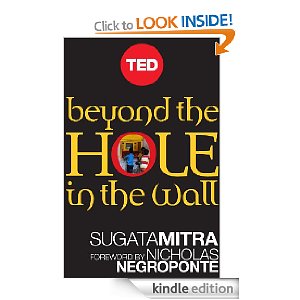This morning I finished reading ‘Beyond the Hole in the Wall: Discover the Power of Self-Organized Learning’ by Sugata Mitra. It’s a short book but it promises much: “This important update on Mitra’s groundbreaking work offers new research and ideas that show how self-directed learning can make kids smarter and more creative. He also provides step-by-step instruction on how to integrate it into any classroom. It’s an important lesson that could reshape our schools and reinvigorate our educational system.” So says the Amazon blurb. I had heard and read articles about the ‘Hole in the Wall’ experiment where Mitra installed a networked PC in a slum in India and the children learned to use it by themselves – truly groundbreaking stuff, life-changing for the children and replicated since in many other areas of India and beyond. So I was really looking forward to hearing about what was next, what was ‘beyond the hole’ and what it could it mean for education here.

Well, let’s just say we didn’t hit it off straight away. In the second introduction Sugata Mitra tells us that “Arithmetic is an outdated life skill, like swordplay or horseriding.” Pardon? He explains that the cashier at a supermarket does not need to know arithmetic – your goodies are scanned and the price automatically displayed. True. It’s quick, convenient and error free. (Usually. I won’t bore you with the story about the time a French check-out person tried to charge me £50 for a bag of tomatoes and a baguette.)
However, I do not work at a checkout, but I do use arithmetic to calculate mentally that I’m not about to spend more than is sensible / desirable / in my bank account – on a weekly shop. How old fashioned! In the current financial climate it is unthinkable that we would not equip our children to manage their money sensibly, confidently and to avoid spending what they don’t have.
In any case it doesn’t really matter, because as soon as the book begins properly we are propelled into the future – the year 2062 to be exact where we meet Rita. In this piece of future fiction Rita has just turned nine – and is thrilled to have been fitted with BSI implants (in her ears!) allowing her to connect seamlessly to the internet and do Hi-Google searches. Fictional segments, revealing more about Rita and how life and education has moved on, are interspersed with “real” ones which provide really fascinating details and research around the legacy of the ‘Hole in the Wall’.I won’t spoil it for you by giving anything else away – because you should read it. But as I read I have to say that initially I was enthralled with Rita’s world and her magic box that can make anything – I want a microFAB! – but several niggling thoughts began to creep up on me…
In 2062 children work in groups around a computer and they learn independently. There is no teacher – just a virtual mediator. Now there is a lot to be said for harnessing technology, working collaboratively and becoming discerning internet users who can present their findings as a website. But that is only one learning and teaching strategy. However, it was the aim or purpose of all of this was perhaps the most disappointing of all:
“Given the appropriate digital infrastructure, a safe and free environment, and a friendly but unknowledgeable mediator, groups of children can…”
Can be masters of their own learning? Can surpass our wildest expectations? Change the world? What? Tell me now – I am so excited!!!
“Groups of children can pass their school-leaving tests (such as GCSE in the UK) on their own.”
And that’s the problem – all this ground-breaking stuff is just a guise for pushing content and retention of facts in order to answer standardised exam questions – when it could be so much more.
Also, poor little Rita – if that is her real future I’d like to go and rescue her. She spent her days working in SOLE’s (Self-Organized-Learning-Environments) with a couple of school chums and her nights with a magic box in a tiny space occupied by her BioDad and his harem of disinterested partners. Her existence lacked joy, meaningful interactions and… well, humanity.
SOLEs? It all seemed a bit soul-less to me.
At the end of the book there are handy step-by-step instructions detailing how to set up and implement Method ELSE (Methods for Emergent Learning Systems) including SOLEs in your own school, should you so wish.
There is one thing that I totally agree with Sugta Mitra about. He says that children should develop their own rational system of belief so that they have a foundation to make decisions on. Absolutely, otherwise if you can’t evaluate what you see, hear or read you might be tempted to rush out and build your own glass SOLE box complete with computers, cameras and a prison warden – sorry – unknowledgeable, but friendly, attendant.
Looking for a radical idea to re-invigorate our education system? You’ll need to look ELSE-where.
Although I do highly recommend that you read the absorbing and thought provoking tale – you can buy it here, and see what you make of it yourself.
Originally posted on Pandora’s Pencil case 02/08/2012
Beyond the Hole in the Wall… but not much further
